An overview of the electronic track
The electronic pinewood derby track is made up of several parts.
Some of these ideas can be used to retrofit existing tracks with
modifications, some are basic assumptions built into the system.
The track that we built has a docking arrangement at both the
top and bottom for an electronics package.
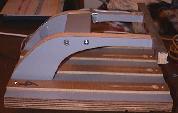
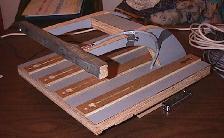 The electronics at the top consists of a bright LED and light sensor
for each lane. The first car to block the light starts the race
clock.
It would be possible to have each lane carry a separate
start clock. However, it either would not matter because all of the
cars cross the starting gate at basically the same time, or it would
matter and the folks who are staring at the end of the track will see finish
orders which may not correspond to the measured elapsed times.
The electronics at the top consists of a bright LED and light sensor
for each lane. The first car to block the light starts the race
clock.
It would be possible to have each lane carry a separate
start clock. However, it either would not matter because all of the
cars cross the starting gate at basically the same time, or it would
matter and the folks who are staring at the end of the track will see finish
orders which may not correspond to the measured elapsed times.
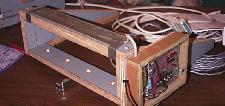 The electronics at the bottom is very similar to the top, except
that each lane gives a separate signal to the computer as each car
crosses the sensor.
The electronics at the bottom is very similar to the top, except
that each lane gives a separate signal to the computer as each car
crosses the sensor.
The five signals (start and four finish lines) are read by a computer
using the parallel port of a standard MS-DOS computer.
A computer running MS-Windows 3.1 will degrade the resolution in timing.
I don't know how Windows-95 will act.
Because the parallel port is tied up talking to the track, the
log printer is connected to a serial port. The log printer must
also be able to show what has printed after a couple of lines.
It seems that the ideal printer for this is an HP500. The newer
HP printers don't have a serial port, nor can you see the output
soon enough.
The program running on the MS-DOS computer is a simple text oriented
program. The schedule is driven off of a data file which contains
the various kids names.
If a child does not show up, the race operator can either put in
a dummy car, or push an appropriate key on the computer to indicate
that the race is over.
At that point the times are on the computer monitor in large
enough characters to be read a fair distance away.
Once the computer operator accepts the race as valid,
an entry is printed on the log printer, and the results are recorded
in appropriate files on disk so that a power fail will not be completely horrible.
(I don't look forward to dealing with that day though.)
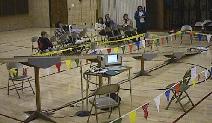
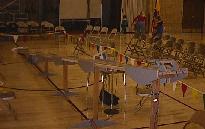
Last modified 27 May 2006
Questions or comments can be sent to
Dave Regan.

 The electronics at the top consists of a bright LED and light sensor
for each lane. The first car to block the light starts the race
clock.
It would be possible to have each lane carry a separate
start clock. However, it either would not matter because all of the
cars cross the starting gate at basically the same time, or it would
matter and the folks who are staring at the end of the track will see finish
orders which may not correspond to the measured elapsed times.
The electronics at the top consists of a bright LED and light sensor
for each lane. The first car to block the light starts the race
clock.
It would be possible to have each lane carry a separate
start clock. However, it either would not matter because all of the
cars cross the starting gate at basically the same time, or it would
matter and the folks who are staring at the end of the track will see finish
orders which may not correspond to the measured elapsed times.


